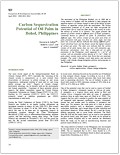| Journal Article |
 |
|
| Article Title | Carbon Sequestration Potential of Oil Palm in Bohol, Philippines | | Author | Florencia B Pulhin, Rodel D. Lasco and Joan P. Urquiola | | Year | 2014 | | Journal Title | Ecosystems & Development Journal | | Institution | College of Forestry and Natural Resources, University of the Philippines | | Volume | 4 | | Issue | 2 | | Pages | 14-19 | | Call Number | JA0604-15 | | Keywords | oil palm, biofuel, Elaeis guineensis, carbon sequestration, climate change mitigation |
|
| Abstract: |
| The enactment of the Philippine Biofuels Act in 2006 led to rising interest in biofuels and the potential to help mitigate the negative impacts of climate change in view of the ability of plant biomass to sequester carbon from the atmosphere. The carbon sequestration potential of oil palm has been recognized for several years but no study has been done in the country to assess the amount of carbon in its biomass. This paper presents the amount of carbon stored in different parts of Elaeis guineensis, commonly known as African oil palm, in plantations with different ages. The carbon content of one plant each from oil palm plantation with ages two, five, six, seven, eight, and nine years was assessed. Results indicate that among different parts, trunk with frond butts and the fronds stored the highest amount of carbon per plant. The data also indicate that the carbon content of oil palm leaves does not vary with plantation age. Moreover, calculations show that a nine-year-old oil palm plantation in the Philippines could sequester 6.1 t ha-1 yr-1 of carbon, with an estimated carbon density of 55 t ha-1. Older oil palm plants contain more carbon than those that are relatively younger. The study’s findings could help policy and decision makers craft climate change mitigation policies and programs in the Philippines. |
|
|
Download file(s): Click icon to download/open file.
|
| |
File Size |
Description |

|
2,537 KB |
Softcopy |
|
|
|
| Viewed in 725 times. Downloaded in 361 times. |